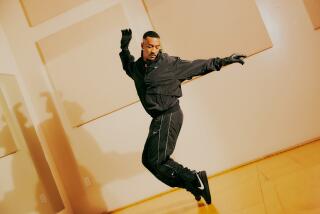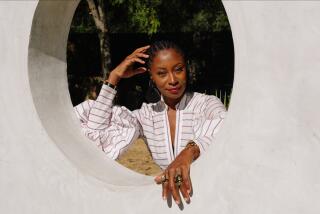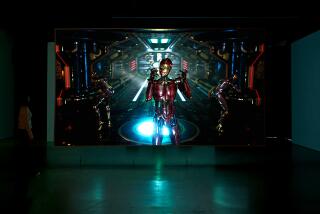Ate9’s Danielle Agami doesn’t need a mirror to know what she’s doing
Dancer-choreographer Danielle Agami, artistic director of Ate9 Dance Company, dislikes voice mail, cameras and mirrors. Indeed, for someone whose career is so body-centric, the mirror has been noticeably absent in her dance practice for more than a decade.
But Israeli-born Agami, 29, has never been one to hew to tradition. When her eight-member troupe premieres her latest full-evening work, “Mouth to Mouth,” at Los Angeles Theatre Center April 26 and May 3, expect a supremely idiosyncratic performance.
“The day Ohad took the mirror away I had the privacy to think about other things that are so much more important than the way I look,” explained Agami during a recent break at UCLA’s Royce Hall Rehearsal Studio.
PHOTOS: Best in dance for 2013 | Laura Bleiberg
That would be Ohad Naharin, artistic director of Tel Aviv-based Batsheva Dance Company, with whom Agami danced from 2002 to 2010. She also served as artistic director of Batsheva Dancers Create and as the troupe’s rehearsal director from 2008 to 2010, before moving to New York the next year, where she headed Gaga USA.
The term for a technique Naharin created and developed nearly 15 years ago while dealing with a back injury, Gaga is a movement language where actions train the body and aid one’s self-awareness in response to verbal prompts from the teacher. (“See if you can reach with your bones outside of your skin.”)
The unblocked body then becomes a vessel for distorted, exaggerated motion, forging a metaphysical connection that is also meant to hearken back to simpler times. Agami likens her class to a playground, where participants are urged to connect to pleasure.
“Gaga changed the way I feel about my body — the confidence, the joy, the option to use my body as a tool for dialogue with myself and the outside world,” said Agami. “That is the core of what I’m trying to teach, how I move and how I choreograph. Gaga lets me put all this inside and gives me freedom to express myself.”
CRITICS’ PICKS: What to watch, where to go, what to eat
On stage, the results of Gaga have a distinct look: From cycles of edgy, quicksilver directional shifts, snake-hip motifs and restless arms, to daringly aggressive moves and rhythmic couplings that might morph into hard-core balances, the method makes the strange seem almost familiar.
It is this liberating of the body that also makes Agami, a dramatic presence with her nearly shaved head, thick eyebrows and dark-as-onyx eyes, such a mesmerizing mover.
During rehearsal — sans mirrors, of course — Agami leads the troupe through a series of steps done in unison that include exaggerated duck-like walking, the occasional split-leg leap and moves reminiscent of toy dipping birds: heads repeatedly bobbing, albeit, for unseen water. There are also rapid bourrées on highly arched feet that could seem satiric but here feel organic.
“I’m trying to have the dancers lead me, to point out their characters, their physical abilities and let that be the engine that helps generate movement for them,” she says. “I want to create a flow that will make sense and won’t make any sense at the same time, that keeps you captivated.”
PHOTOS: The most fascinating arts stories of 2013
And it does. Moving from New York to Seattle, where Cornish College of the Arts supported an Agami residency with Velocity Dance Center, the Israeli established Ate9 in June 2012. But finding Seattle a bit tame, the director brashly moved to L.A. in January 2013, taking her dancers with her. (Of the original group, three remain: Sarah Butler, Genna Moroni and Ariana Daub.)
Since arriving in town, Agami has become choreography’s It girl. At last year’s L.A. Dance Festival, The Times described an excerpt of her first full-evening work, “Sally Meets Stu,” as “an amped-up, balletic folk dance, different styles bolted together with a hypnotic rhythmic expertise.”
More recently, Ate9 completed a week’s residency at UCLA, performing two shows for high school students. Center for the Art of Performance at UCLA’s artistic director, Kristy Edmunds, said that L.A. is “inspiring to Danielle’s aesthetic ideas.
“As a curator,” continued Edmunds, “I think her priority is not to imagine how to exploit riches in service to her ‘brand’ but instead to position her artistic ideas within an internationally engaged ‘art city’ in pursuit of creating great work — from here. I respect that diligence and awareness.”
PHOTOS: Arts and culture in pictures by The Times
Last spring, Yuval Sharon, artistic director of the avant-garde opera troupe the Industry, tapped Agami to choreograph members of L.A. Dance Project for “Invisible Cities,” composer Christopher Cerrone’s headphone opera at Union Station. Then, in November, Agami and company won the $10,000 Division I Grand Prize Award at the McCallum Theatre’s Choreography Festival in Palm Desert. (With that money, the troupe presents itself in two concerts in New York City in late May.)
This month Sharon, 34, also had Agami and dancers perform in the Industry’s “In C,” an installation featuring Terry Riley’s iconic score and inflatable air dancers at the Hammer Museum.
“The aura Danielle exudes is unforgettable,” said Sharon. “I also think she’s among the top choreographers in terms of musical sophistication, where the music is a kind of scalpel for personal reactions and movements, which are thrilling, odd, puzzling, wonderful and sometimes hilarious. But it’s the counterpoint with the music that takes it to another level.”
To that end, Agami is collaborating with composer Jodie Landau for “Mouth to Mouth,” the troupe’s first work to feature live music, performed by seven members of the contemporary ensemble wild Up. Landau, 22, who also worked on “Invisible Cities” and graduates from CalArts next month, said he became hooked after seeing Ate9 last year.
CHEAT SHEET: Spring arts preview 2014
“What attracted me to Danielle’s work is that it’s about the experience, not only of the dancers and the audience but creating something in the space that is sensory and enjoyable,” explained Landau, who also performs on vibraphone and vocals.
Landau added that he was going for timelessness in his music, which ranges from gentle and pulsating to neo-romantic. “Music for sound’s sake is different from music for dance. I see the dancers as a musical element, and they are so strong on their own I don’t need to do as much as I would in a concert context to fill the space, both visually and orally.”
Agami, who also sets Naharin’s work on companies, including Alvin Ailey American Dance Theater, the Juilliard School and Ballet Atlanta, agrees she’s riding a wave and credits much to the Batsheva choreographer, whom she speaks to frequently.
“I can’t measure how important our relationship is, especially because it is ongoing. It helps me, not only to grow but to have perspective and to listen to his perspective. He’s [over] 60,” added Agami, “and I’ve been listening since I’m 20. It’s not a shortcut, but he hands you a set of keys you can use because of the process and research he did.”
RELATED: More theater & dance coverage by The Times
The feeling is mutual. Naharin wrote in an email, “Danielle possesses beauty, intelligence, imagination, musicality, explosiveness, movement coordination, clarity, delicacy and passion. She is the ultimate example of what I often say about dancers I work with — that they are my teachers.”
Agami may not like mirrors — or cameras — but she likes being on stage. “I like to disappear when possible, that’s the truth. I don’t enjoy being the center of attention. But it’s happening now because this is the role I’m doing.
“I also believe in the ability of my dancers to excite and to make people fall in love,” she added. “All the rest is just something I have to deal with.”
More to Read
The biggest entertainment stories
Get our big stories about Hollywood, film, television, music, arts, culture and more right in your inbox as soon as they publish.
You may occasionally receive promotional content from the Los Angeles Times.






